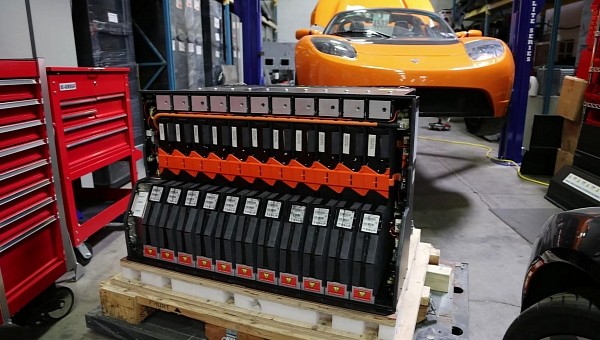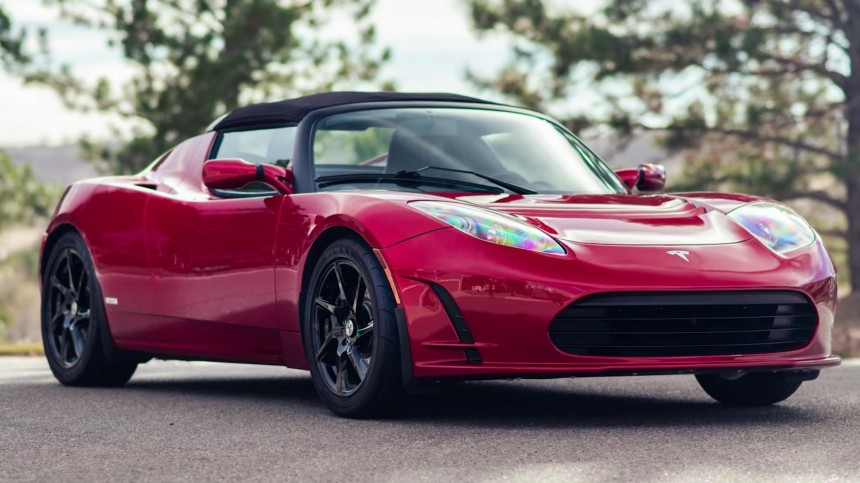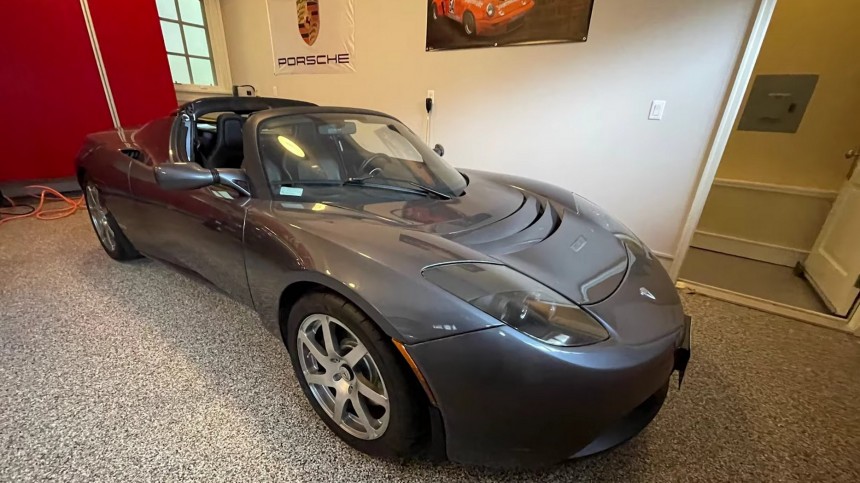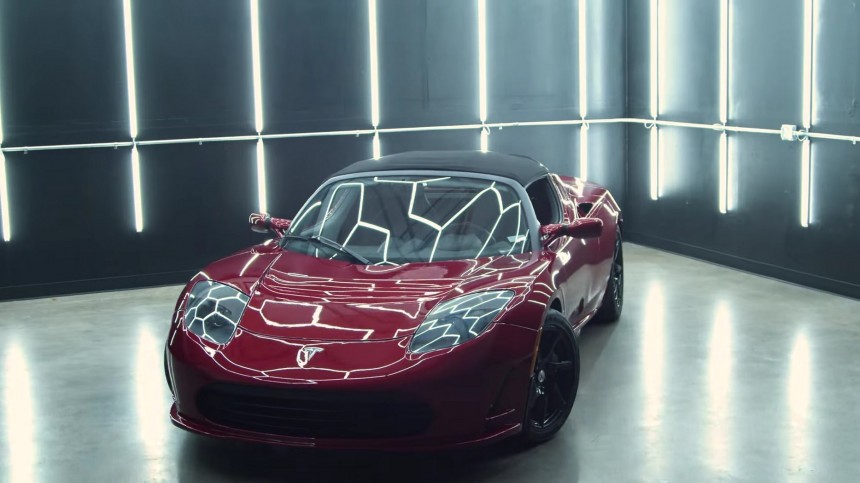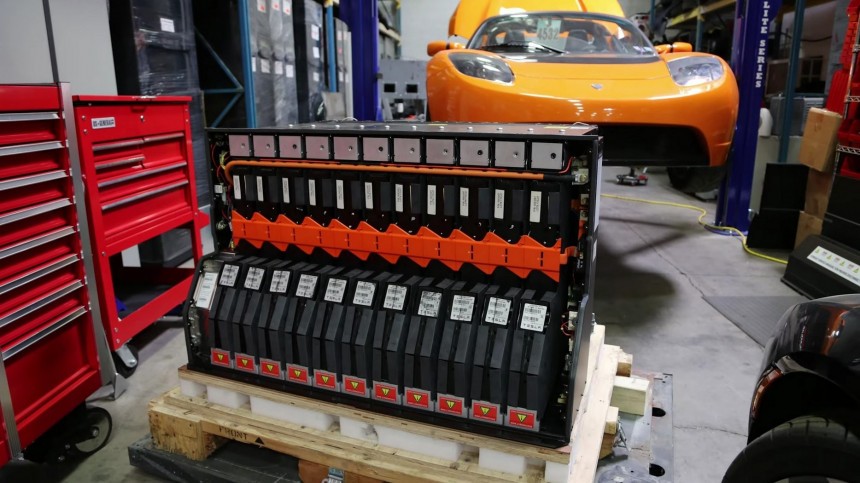Pete Gruber started his new video by praising how durable the original Tesla Roadster battery packs are. They were conceived to last ten years, but most have made it to fifteen years (so far) with no signs of dropping the ball. While that should be great news for BEV advocates, the Gruber Motors CEO was actually introducing an issue: end-of-life battery packs on the Roadster, more specifically, 2016 replacement battery packs.
Tesla started selling them eight years after the release of the Roadster. Instead of the 2.2 Ah 18650 cells the electric sports car had from the very beginning, it had 3.2 Ah cells. The replacement battery packs cost $32,000, which could seem like a sweet deal considering the promised range improvements. The entry-level Roadster (called 1.5 Standard) started at $98,950, while the flagship 2.5 Sport demanded $128,500, and both offered a range of around 200 miles. The replacement battery pack promised more than 400 miles of range. Gruber said it never delivered that much. Sadly, that was not the only problem with that battery pack.
The CEO said Tesla stopped selling the replacement packs in 2019 – when vehicles equipped with them failed to surpass 200 miles of range. The Tesla engineering team regrouped to understand the issue, and a second-generation battery pack entered production in 2020. According to Gruber, it was at that point that Tesla Roadster values dropped the most, to around $35,000 – almost as much as the replacement battery packs cost. In his opinion, “no one was keen on buying” a vehicle that could eventually stop driving.
Ironically, we have 15-year-old battery packs that were supposed to last ten years and are still working, and 7-year-old components failing when they were expected to endure at least three years more. If production stopped from 2019 until 2020, Tesla probably knew what was wrong with them. If it didn’t, at least it knew that something was wrong with them. Gruber suspects it has to do with quality issues involving the 18650 cells that the replacement packs contain.
Mark Schaeffner led the team at Gruber Motors responsible for diagnosing the problem. He told me that they suspect these cells may lack enough electrolytes because this is what causes high impedance in lithium-ion cells. This phenomenon allows cells to charge normally but makes them “rapidly discharge under load.”
“In the case of these cars, there were no resistive cells. The telltale sign that a pack has resistive cells is that it rapidly loses charge when the car is not on. The packs in question don’t exhibit his behavior at all. They charge properly and, when the car is not on, discharge at a rate similar to that of a good battery pack. Also, there are no single bricks that exhibit symptoms. The entire battery – all sheets, all bricks – exhibit the same symptoms simultaneously.”
When the Gruber Motors team got in touch with the first two cases, they also learned that several other Roadsters with the 2016 replacement battery pack were also presenting the issue. That made Gruber say in the video that these components would probably also fail if they were just sitting somewhere, waiting to be installed on a Roadster.
The independent shop managed to contact Tesla and asked it to validate its diagnostics. One of the two Roadsters affected by the problem that the shop received went to a nearby Tesla Service Center for more tests. Considering how Tesla communicates with the public, the press, and its customers, hearing about the official cause would represent a profound policy change – especially considering how much time it already had to investigate and disclose what was wrong with these battery packs.
Whether we have an official explanation or not, Gruber seemed to be more interested in what these cases can teach. In his words, they are the first example of how dying battery packs will behave. These ones on the Roadster lose power over 30 mph, something some owners point out as a squishy accelerator pedal. The affected Roadsters do not go over 60 mph and also have issues with climbs. Schaeffner said the best description for the behavior is that the EVs are anemic. The CEO said one of his customers lives on a hill and could not get his Roadster back in his home’s garage due to the issue.
In the analysis performed by his shop, Gruber compared the Roadsters with 2016 battery packs with 2008 units and with the 2020 replacement packs. The main difference they present is a “substantially lower voltage per brick” when the accelerator pedal is pressed to 100%. As Schaeffner told us, all battery modules show the same condition.
“The other major component in the high-voltage system is the PEM (power electronics module). After verifying that components such as the HVAC unit were performing normally, we switched PEMs between the suspect Roadster and a known good Roadster and performed test drives. The performance of the two cars was unaffected by the switch in PEMs – the poorly performing car still performed poorly, and the good car performed properly.”
Curiously, Gruber Motors had already seen a similar issue but in entirely different applications.
“In 2014, our sister company Gruber Power Services installed VRLA lead-acid batteries in critical-power uninterruptible power systems (UPSs) at several customer sites. These batteries later proved to be deficient due to a manufacturing defect. They exhibited the same type of symptoms we’re experiencing with the Roadsters.”
Gruber is now waiting for Tesla to disclose what is wrong with the battery packs. While those originally installed in Tesla cars had eight years of warranty, the replacement packs may have a lower protection period. If it also is eight years, the 2016 replacement packs are covered until 2024. But are they?
The CEO said Tesla stopped selling the replacement packs in 2019 – when vehicles equipped with them failed to surpass 200 miles of range. The Tesla engineering team regrouped to understand the issue, and a second-generation battery pack entered production in 2020. According to Gruber, it was at that point that Tesla Roadster values dropped the most, to around $35,000 – almost as much as the replacement battery packs cost. In his opinion, “no one was keen on buying” a vehicle that could eventually stop driving.
Mark Schaeffner led the team at Gruber Motors responsible for diagnosing the problem. He told me that they suspect these cells may lack enough electrolytes because this is what causes high impedance in lithium-ion cells. This phenomenon allows cells to charge normally but makes them “rapidly discharge under load.”
“In the case of these cars, there were no resistive cells. The telltale sign that a pack has resistive cells is that it rapidly loses charge when the car is not on. The packs in question don’t exhibit his behavior at all. They charge properly and, when the car is not on, discharge at a rate similar to that of a good battery pack. Also, there are no single bricks that exhibit symptoms. The entire battery – all sheets, all bricks – exhibit the same symptoms simultaneously.”
The independent shop managed to contact Tesla and asked it to validate its diagnostics. One of the two Roadsters affected by the problem that the shop received went to a nearby Tesla Service Center for more tests. Considering how Tesla communicates with the public, the press, and its customers, hearing about the official cause would represent a profound policy change – especially considering how much time it already had to investigate and disclose what was wrong with these battery packs.
Whether we have an official explanation or not, Gruber seemed to be more interested in what these cases can teach. In his words, they are the first example of how dying battery packs will behave. These ones on the Roadster lose power over 30 mph, something some owners point out as a squishy accelerator pedal. The affected Roadsters do not go over 60 mph and also have issues with climbs. Schaeffner said the best description for the behavior is that the EVs are anemic. The CEO said one of his customers lives on a hill and could not get his Roadster back in his home’s garage due to the issue.
“The other major component in the high-voltage system is the PEM (power electronics module). After verifying that components such as the HVAC unit were performing normally, we switched PEMs between the suspect Roadster and a known good Roadster and performed test drives. The performance of the two cars was unaffected by the switch in PEMs – the poorly performing car still performed poorly, and the good car performed properly.”
“In 2014, our sister company Gruber Power Services installed VRLA lead-acid batteries in critical-power uninterruptible power systems (UPSs) at several customer sites. These batteries later proved to be deficient due to a manufacturing defect. They exhibited the same type of symptoms we’re experiencing with the Roadsters.”
Gruber is now waiting for Tesla to disclose what is wrong with the battery packs. While those originally installed in Tesla cars had eight years of warranty, the replacement packs may have a lower protection period. If it also is eight years, the 2016 replacement packs are covered until 2024. But are they?
